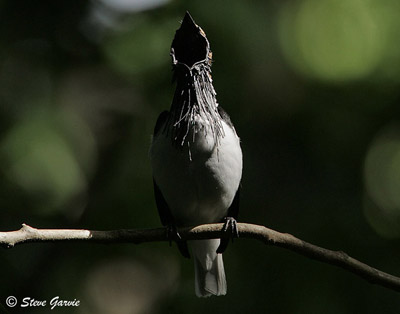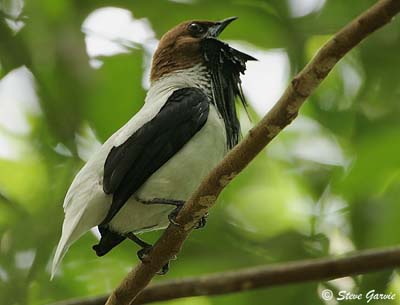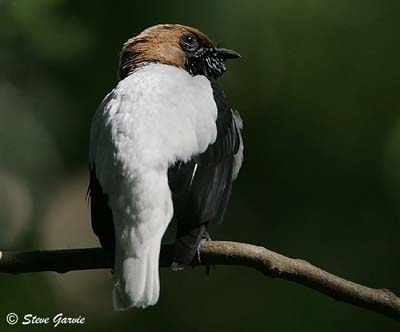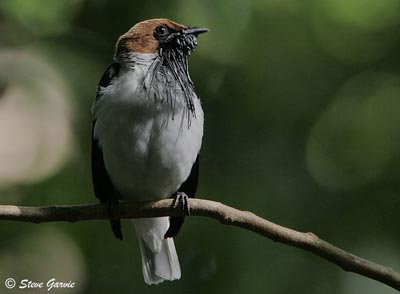
Bearded Bellbird
Procnias averano
Passeriforme Order - Cotingidae Family
BIOMETRICS:
Length : 26,5-28 cm ; Weight : 127-135 g
DESCRIPTION:
Bearded Bellbird is an arboreal species, mainly feeding on fruits.
Adult male has silvery-white plumage, except the black wings. We can see a pinkish patch of bare skin on the side of the thighs.
Head is chocolate-brown. Face is black, from lores to malar area. The throat shows black beard, made with extensible black wattles, visible from the base of the lower mandible, through the chin and the throat where they are longer.
The short, blackish bill has wide gape, allowing the bird to swallow whole large fruits. Eyes are dark brown. Legs and feet are dark grey to blackish.

Female is very different with olive-green upperparts. Underparts are mostly yellow with conspicuous olive-green streaks. Vent is pale yellow.
Head is darker olive-green. Chin and throat are as the underparts, and without beard. Bill, eyes and legs are similar to those of the male.
Immature resembles female and has adult plumage at about one or two years of age. In young male, wattles begin to appear at one year.
We find two subspecies: Procnias averano averano, and Procnias averano carnobarba, with pale grey body plumage.
VOICE: SOUNDS BY XENO-CANTO
At about 15 months old, the Bearded Bellbird male only utters harsh squawks. Five months later, it is able to utter the loud “bock” of the adults. But the repeated hammering or bell-like call of adults “tonk-tonk-tonk-tonk…” needs some months more. Female is silent.
Several regional calls are known as dialects.

HABITAT:
Bearded Bellbird lives in wet forests and mainly submontane Primary Rain forest. It is found from hill country up to 1900 metres of elevation.
RANGE:
Bearded Bellbird is found in tropical parts of South America, from extreme northern Colombia, Venezuela, northern Brazil, and the Guianas, and also north-eastern Brazil for Procnias averano averano.
BEHAVIOUR:
Bearded Bellbird usually forages alone or in pairs. It feeds mainly on fruits and berries, usually taken in flight sallies. It swallows them whole thanks to the wide gap of its bill. This species consumes the fruits of more of 40 different plants, and particularly the fruits of the Lauraceae family.
The male often sings from high perch from where the surrounding area can be overlooked.
During the breeding period, the male performs displays. Several males form displaying groups. They display in a lek or mating arena. There are only 3 to 4 males spaced at least 100 metres apart. Each male utters its loud hammering call from high perches such as treetops, in order to advertise themselves. This area is near the forest.

If a female is attracted, the male flies down to a small tree in the close forest. If female follows it being receptive, they mate on a horizontal branch of the small tree. Before to copulate, the male performs series of jumps, while it gives its repeated calls, ending in a final “bock”, as it leaps on the female’s back. It also displays the pinkish patches of the thighs, and wattles are conspicuously exhibited during these displays.
Usually, the lek involves competition for this place. When the owner is absent, the calling perches are taken by other younger males. There is a continual competition by several males of varying ages, for a small number of mating arenas.
Bearded Bellbird is mostly resident in its range. Immatures perform some local movements. In Venezuela, the birds perform only altitudinal movements, according to the season.
FLIGHT:
Bearded Bellbird has agile flight, and performs flight sallies for food.
REPRODUCTION:
Breeding season varies, according to the region.
The polygamous male does not help in nesting duties.
Bearded Bellbird female builds a loose structure, a small platform made with some thick twigs at the base. The shallow cup is made with finer twigs. These twigs are slightly curved and they interlock very well. The nest is situated in a tall tree in the forest, relatively close to the edge. It is built at about 2, 5 to 15 metres above the ground.

Female lays only one buff-coloured egg, with dark brown markings. Incubation lasts about 23 days, by female alone. The young is fed by regurgitated fruits, always by female. She flies swiftly and silently, perching near the nest-site in order to watch for potential danger before to hop to the nest.
Young fledge about 30 to 33 days after hatching.
DIET:
Bearded Bellbird feeds mainly on fruits and berries, and particularly the fruits of the family Lauraceae and Burseraceae. The bird plucks the fruits in flight sally, and swallows them whole.
It may take some insects in short aerial sallies, or taken in flight from foliage and vegetation.
This bird is able to swallow relatively large fruits thanks to its wide gape. The fruits of these trees species are rich in fats and proteins. In addition, these plants have well presented fruits growing towards the exterior, allowing the bird to pluck them in flight.

PROTECTION / THREATS / STATUS:
Bearded Bellbird is uncommon, fairly common or local, according to the range.
In some parts of the habitat (NE Brazil) the Bearded Bellbird is heavily trapped for cagebird-trade, and this species is also threatened by habitat loss.
The subspecies Procnias averano carnobarba lives in several protected areas.
The tendency of the Bearded Bellbird to disperse or move over long distances allows this species to live in separated forested areas.
At this moment, this species is not globally threatened.
Fr: Araponga barbu
All : Bartkotinga
Esp : Campanero Barbudo
Ital : Campanaro barbuto
Nd : Baardklokvogel
Russe : Чернокрылый звонарь
Photographs by Steve Garvie
RAINBIRDER Photo galleries
Text by Nicole Bouglouan
Sources:
HANDBOOK OF THE BIRDS OF THE WORLD Vol 9 - by Josep del Hoyo - Andrew Elliot - David Christie - Lynx Edicions - ISBN: 8487334695
Wikipedia (Wikipedia, The Free Encyclopedia)